Solar water heating systems are eco-friendly solutions that can greatly reduce your energy bills and carbon footprint. These systems use solar collectors to harness the sun's energy, heating water for your home. You'll find two main types: flat plate collectors and evacuated tube collectors, each with unique benefits. Choosing between active and passive systems depends on your climate, budget, and hot water needs. While initial costs are higher than traditional systems, you'll see long-term savings and may qualify for government incentives. Proper sizing, installation, and maintenance are essential for peak performance. Explore further to uncover the full potential of solar water heating for your home.
Understanding Solar Water Heating Systems

With the rising demand for eco-friendly solutions, solar water heating systems have gained significant popularity. These systems harness the sun's energy to heat water for your household needs, reducing reliance on fossil fuels and lowering electricity bills. They consist of solar collectors, usually mounted on your roof, and a storage tank to hold the heated water.
There are two main types of solar water heaters: active and passive. Active systems use pumps to circulate water or heat-transfer fluids, while passive systems rely on natural convection. You'll find two varieties of active systems: direct circulation, which pumps household water through the collectors, and indirect circulation, which uses a heat-transfer fluid to warm the water.
When considering a solar water heater, you'll need to factor in your climate, available roof space, and hot water needs. While the initial investment may be higher than traditional water heaters, you'll benefit from long-term energy savings and reduced carbon emissions.
It's essential to properly size your system and guarantee it's installed by a qualified professional to maximize efficiency and longevity.
Types of Solar Collectors
When considering solar water heating systems, you'll encounter two main types of solar collectors.
Flat plate collectors consist of an insulated box with a dark absorber plate under glass or plastic covers, efficiently capturing solar energy.
Evacuated tube collectors, on the other hand, use a series of glass tubes containing absorber plates, offering higher efficiency in colder climates due to their superior insulation.
Flat Plate Collectors
Flat plate collectors are among the most common and versatile types of solar collectors used for water heating. They consist of a dark, flat-plate absorber that captures solar energy, a transparent cover to reduce heat loss, and a heat transfer fluid circulating through pipes.
You'll often find these collectors mounted on rooftops or walls, facing the sun to maximize exposure. These collectors work efficiently in various climates and can heat water for domestic use or support space heating systems.
They're relatively simple in design, making them cost-effective and easy to maintain. When you're considering flat plate collectors, keep in mind their key components:
- Absorber plate: A dark-colored surface that absorbs sunlight and converts it to heat
- Glazing: A transparent cover that allows sunlight to pass through while trapping heat
- Insulation: Material surrounding the collector to minimize heat loss
You'll appreciate the durability of flat plate collectors, as they can withstand harsh weather conditions. They're also adaptable, working well with both active and passive solar water heating systems.
Evacuated Tube Collectors
Moving from flat plate collectors, we encounter another innovative solar water heating technology: evacuated tube collectors. These systems consist of rows of parallel glass tubes, each containing a heat pipe surrounded by a vacuum. This design considerably reduces heat loss, making them more efficient than flat plate collectors, especially in colder climates.
You'll find that evacuated tube collectors can maintain high performance even in low light conditions or when the sun isn't directly overhead. They're particularly effective in capturing diffuse solar radiation on cloudy days. The vacuum insulation allows them to reach higher temperatures, making them suitable for both residential and commercial applications.
Installation is relatively straightforward, as the tubes are lightweight and can be individually replaced if damaged. You can mount them vertically on roofs or walls, offering flexibility in positioning.
While they're generally more expensive than flat plate collectors, their higher efficiency can offset the initial cost over time.
However, you should consider that snow can accumulate between the tubes, potentially reducing efficiency in snowy regions. Regular maintenance is also vital to guarantee peak performance and longevity of your evacuated tube collector system.
Passive Vs Active Systems
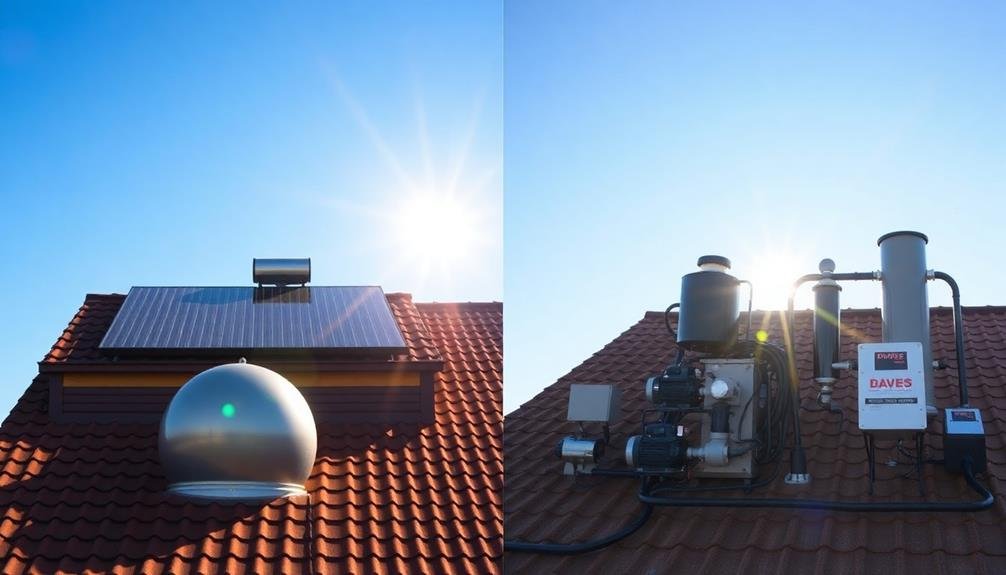
When considering solar water heating systems, you'll need to choose between passive and active designs.
To make an informed decision, you should compare their key features, including installation complexity, maintenance requirements, and overall performance.
Additionally, you'll want to examine the efficiency and cost differences between these two types of systems, factoring in both initial investment and long-term operational expenses.
Key Features Compared
Between passive and active solar water heating systems, several key features distinguish their operation and efficiency. Passive systems rely on natural convection to circulate water, while active systems use pumps and controllers. This fundamental difference impacts their overall performance and suitability for various climates.
You'll find that passive systems are generally simpler and more cost-effective, requiring minimal maintenance. They're ideal for warm, sunny regions where freezing isn't a concern.
Active systems, on the other hand, offer greater flexibility and efficiency, especially in colder climates. They can use antifreeze solutions to prevent freezing and provide more consistent hot water output.
When comparing these systems, consider these key features:
- Heat collection: Passive systems use batch collectors or thermosiphon setups, while active systems employ flat-plate or evacuated tube collectors.
- Energy consumption: Passive systems don't require external power, whereas active systems need electricity for pumps and controls.
- Installation complexity: Passive systems are often easier to install, but active systems offer more placement options and can be integrated with existing water heaters.
Your choice between passive and active solar water heating will depend on your climate, budget, and specific hot water needs.
Efficiency and Cost Analysis
Efficiency and cost are essential factors when choosing between passive and active solar water heating systems.
Passive systems are generally more affordable upfront, with prices ranging from $1,000 to $3,000. They're simpler, require less maintenance, and have no moving parts, making them more durable. However, they're less efficient, especially in colder climates, and may need backup heating.
Active systems, while pricier at $3,000 to $7,000, offer higher efficiency and better performance in various climates. They use pumps and controllers to circulate water, allowing for more precise temperature control. You'll see faster heating times and higher overall energy savings with active systems.
When analyzing long-term costs, consider energy savings. Passive systems can reduce water heating bills by 50-80%, while active systems can cut them by 60-90%.
Factor in maintenance costs: passive systems need minimal upkeep, but active systems require periodic pump and controller checks.
Your climate plays a vital role in efficiency. In sunny, warm regions, passive systems may suffice. For colder or cloudier areas, active systems will likely provide better year-round performance and energy savings.
Solar Storage Tank Options
Solar storage tanks play an essential role in maximizing the efficiency of your solar water heating system. These tanks store the heated water from your solar collectors, guaranteeing you have hot water available even when the sun isn't shining.
You'll find two main types of solar storage tanks: direct and indirect systems.
Direct systems circulate potable water directly through the solar collectors and into the storage tank. They're simple and cost-effective but are best suited for warmer climates where freezing isn't a concern.
Indirect systems use a heat transfer fluid that circulates through the collectors and a heat exchanger in the tank, making them ideal for colder regions.
When choosing a solar storage tank, reflect on these key factors:
- Tank size: Confirm it's large enough to meet your household's hot water needs.
- Insulation quality: Look for tanks with high R-value insulation to minimize heat loss.
- Material durability: Opt for corrosion-resistant materials like stainless steel or lined steel.
You'll also want to contemplate additional features like backup heating elements, pressure relief valves, and temperature controls.
Heat Transfer Fluids Explained
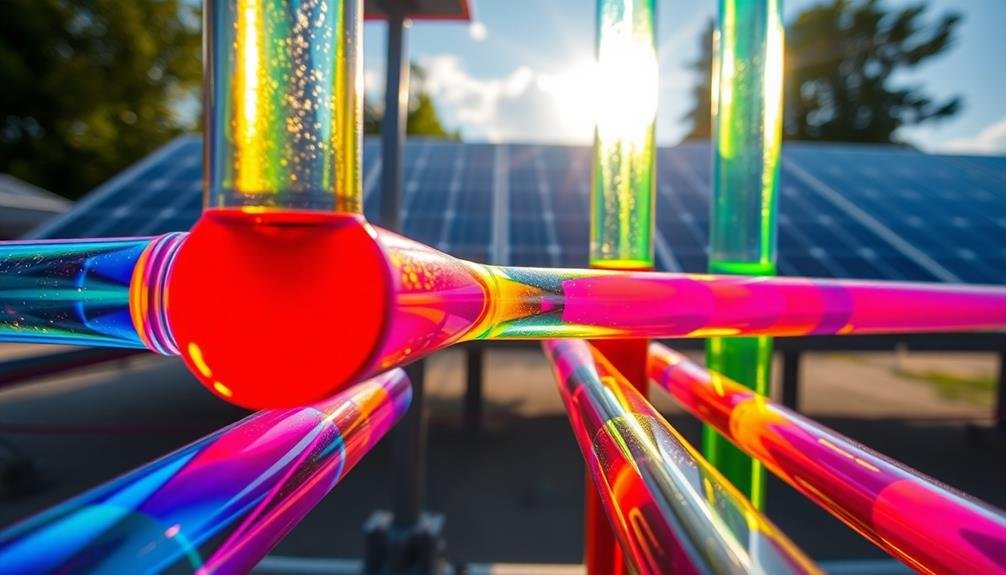
Heat transfer fluids play a vital role in your solar water heating system's efficiency and longevity.
You'll need to take into account the types of fluids available, such as water, glycol, and silicone-based options, and select the most appropriate one based on your climate and system requirements.
It's important to understand the maintenance needs and replacement intervals for your chosen fluid to guarantee peak performance and prevent system damage.
Types of Transfer Fluids
Transfer fluids play a crucial role in eco-friendly water heating systems, acting as the lifeblood that circulates heat from the collector to your storage tank.
You'll find several types of transfer fluids used in solar water heating systems, each with its own advantages and considerations.
Water is the most common and cost-effective transfer fluid. It's an excellent heat conductor and environmentally friendly. However, it's prone to freezing in colder climates, which can damage your system.
To combat this, you might opt for an antifreeze solution, typically a mix of water and propylene glycol. This option offers better freeze protection but requires periodic maintenance to prevent degradation.
For high-temperature applications, you'll find specialized synthetic oils that can withstand extreme heat without breaking down. These fluids are ideal for industrial use but come with a higher price tag.
When choosing a transfer fluid, consider:
- Your local climate and temperature ranges
- The system's operating temperature requirements
- Maintenance needs and long-term costs
Fluid Selection Criteria
When selecting a heat transfer fluid for your eco-friendly water heating system, you'll need to take into account several essential factors to guarantee peak performance and longevity.
First, consider the fluid's freezing and boiling points, which should align with your local climate conditions. You'll want a fluid that remains stable across a wide temperature range to prevent system damage.
Next, evaluate the fluid's thermal conductivity and specific heat capacity. These properties determine how efficiently the fluid can transfer heat from the collector to your water tank. Higher values generally indicate better performance.
Corrosion resistance is vital to protect your system's components. Look for fluids that won't degrade pipes, pumps, or other materials in your setup.
Additionally, assess the fluid's viscosity, as it affects pumping efficiency and heat transfer rates.
Consider the fluid's toxicity and environmental impact. Opt for non-toxic, biodegradable options to minimize risks in case of leaks.
Maintenance and Replacement
To guarantee the longevity and efficiency of your eco-friendly water heating system, you'll need to stay on top of heat transfer fluid maintenance and replacement. Regular checks and timely interventions can prevent costly repairs and assure peak performance.
You should inspect your system's fluid levels, color, and consistency at least twice a year.
When it's time to replace the heat transfer fluid, follow these steps:
- Drain the old fluid completely, ensuring no residue remains in the system.
- Flush the system with a cleaning solution to remove any built-up deposits or contaminants.
- Refill with fresh, high-quality heat transfer fluid that matches your system's specifications.
Don't forget to check the pH levels of your fluid annually. If it drops below 7, it's time for a replacement.
Also, keep an eye out for signs of fluid degradation, such as unusual odors, discoloration, or decreased system efficiency.
Sizing Your Solar Water Heater
Selecting the right size for your solar water heater is vital for ideal performance and efficiency. To determine the appropriate size, you'll need to evaluate several factors.
First, calculate your household's daily hot water usage. This typically ranges from 20 to 40 gallons per person, depending on individual habits.
Next, assess your climate and average sun exposure. Areas with less sunlight may require larger systems to compensate. Evaluate your available roof space or installation area, as this will limit the size of your solar collectors.
You'll also need to take your budget into account, as larger systems are more expensive.
For most residential applications, a 50 to 80-gallon tank is suitable for families of 3-4 people. However, if you have high hot water demands or live in a colder climate, you might opt for a larger 80 to 120-gallon system.
It's important to avoid oversizing, as this can lead to wasted energy and unnecessary costs. Conversely, an undersized system won't meet your hot water needs.
Consult with a professional solar installer to get an accurate assessment of your specific requirements and ascertain you choose the best size for your solar water heater.
Installation Considerations and Costs
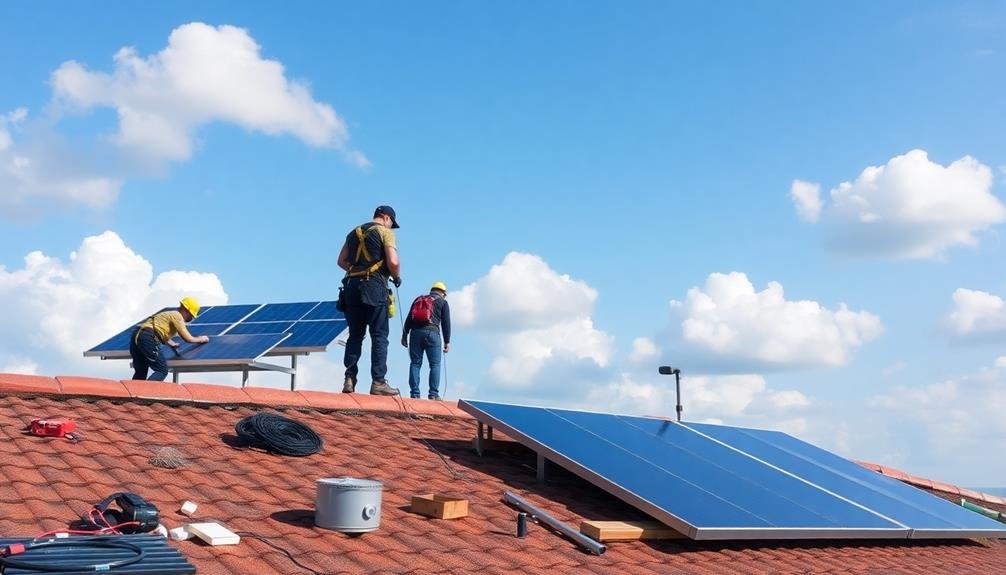
Installation of a solar water heater requires careful planning and consideration of several key factors.
You'll need to assess your roof's structural integrity, orientation, and available space. South-facing roofs in the Northern Hemisphere are ideal, but southeast and southwest orientations can also work effectively. Confirm your roof can support the additional weight of the solar collectors and storage tank if it's roof-mounted.
Consider local building codes and permit requirements before installation. You may need to hire a professional installer certified in solar water heating systems. They'll help you navigate the complexities of integrating the system with your existing plumbing and electrical setup.
Costs vary depending on system size, type, and installation complexity. On average, you can expect to spend:
- $3,000 to $5,000 for a small, basic system
- $6,000 to $10,000 for a medium-sized system with more advanced features
- $15,000 or more for large, high-end systems with complex installations
While the initial investment may seem high, remember that solar water heaters can greatly reduce your energy bills and often pay for themselves within 5-10 years.
Many regions offer tax incentives or rebates to offset installation costs, making the switch to solar even more attractive.
Maintenance and Troubleshooting Tips
While solar water heaters are generally low-maintenance, regular upkeep is essential for guaranteeing ideal performance and longevity.
You'll need to inspect your system annually, checking for leaks, corrosion, or damage to collectors and piping. Clean the collectors periodically to remove dirt, leaves, or debris that may reduce efficiency.
For troubleshooting, first check if your backup heating system is functioning correctly. If you're not getting hot water, inspect the controller and pump for proper operation. Verify that valves are open and the system is filled with fluid.
In cold climates, verify antifreeze levels are adequate to prevent freezing.
If you notice reduced efficiency, air in the system could be the culprit. Bleeding the air out of the pipes can often resolve this issue. For more complex problems, consult your system's manual or contact a professional.
Don't forget to test the pressure relief valve annually and replace the sacrificial anode rod in your storage tank every 3-5 years to prevent corrosion.
Energy Savings and ROI
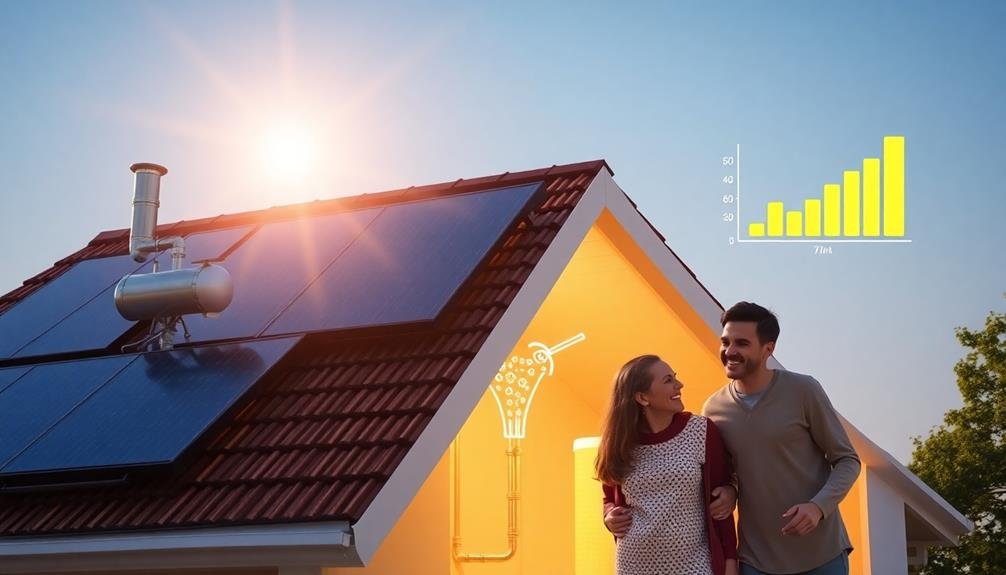
Proper maintenance isn't the only factor that makes solar water heaters attractive; their potential for energy savings and return on investment (ROI) can be significant. By harnessing the sun's energy, you'll reduce your reliance on traditional energy sources, leading to lower utility bills and a smaller carbon footprint.
To understand the potential savings, consider these factors:
- Your current water heating costs
- The initial investment in a solar water heating system
- Available incentives and rebates in your area
On average, you can expect to save 50-80% on your water heating costs annually. The exact amount depends on your location, system size, and hot water usage.
While the upfront costs may seem high, many homeowners see a full ROI within 5-10 years.
Don't forget to factor in increased property value. Homes with solar water heaters often sell faster and at higher prices.
You'll also be insulated from rising energy costs, as your primary energy source – the sun – is free and abundant.
Integrating With Existing Systems
Seamlessly integrating solar water heaters with existing systems is an essential step in maximizing their efficiency and benefits. You'll need to take into account your current plumbing setup and water heating infrastructure when installing a solar water heating system.
Most solar water heaters can work alongside your existing water heater, acting as a pre-heater to reduce the workload on your conventional unit.
For retrofit installations, you'll typically need to add a solar storage tank and connect it to your existing water heater. This setup allows the solar-heated water to feed into your conventional system, reducing its energy consumption.
If you're replacing your entire water heating system, you might opt for a single tank solution that combines solar and backup heating.
You'll also need to integrate the solar collectors with your roof. Make sure your roof can support the additional weight and that the collectors are properly oriented for maximum sun exposure.
Don't forget to take into account local building codes and permits when planning your integration. Proper system sizing is important to avoid overproduction or underperformance, so consult with a professional to determine the best configuration for your needs.
Climate Considerations for Solar Heating

For ideal performance of solar water heating systems, climate plays an essential role. You'll need to contemplate your region's solar radiation levels, temperature variations, and weather patterns when choosing and installing a solar water heater.
In areas with abundant sunlight year-round, like the southwestern United States, solar water heaters can operate at peak efficiency. However, in regions with frequent cloudy days or harsh winters, you might need to supplement your system with a backup heat source.
When evaluating your climate's suitability for solar water heating, keep these factors in mind:
- Annual days of sunshine and solar intensity
- Average temperatures during winter months
- Frequency of extreme weather events like hail or hurricanes
You'll also want to reflect on the positioning of your solar collectors. In colder climates, you may need to adjust the angle of your panels seasonally to maximize sun exposure.
Additionally, areas prone to freezing temperatures require systems with freeze protection mechanisms, such as drain-back or closed-loop designs.
Government Incentives and Rebates
While climate considerations are important for solar water heating, financial factors also play a considerable role in adopting eco-friendly water heating solutions. Government incentives and rebates can considerably reduce the upfront costs of installing solar water heaters, making them more accessible to homeowners and businesses.
You'll find various incentives available at federal, state, and local levels. The federal government offers a 30% tax credit for solar water heating systems installed through 2032. Many states provide additional tax credits, grants, or rebates.
For example, California offers rebates up to $4,366 for single-family homes and $800,000 for multifamily buildings. Local utilities may also offer incentives. Check with your energy provider for specific programs in your area. Some cities and counties provide property tax exemptions for solar installations.
To maximize your savings, combine multiple incentives. Research available options through the Database of State Incentives for Renewables & Efficiency (DSIRE). Remember, incentives change frequently, so stay informed about current offerings.
DIY Solar Water Heater Projects
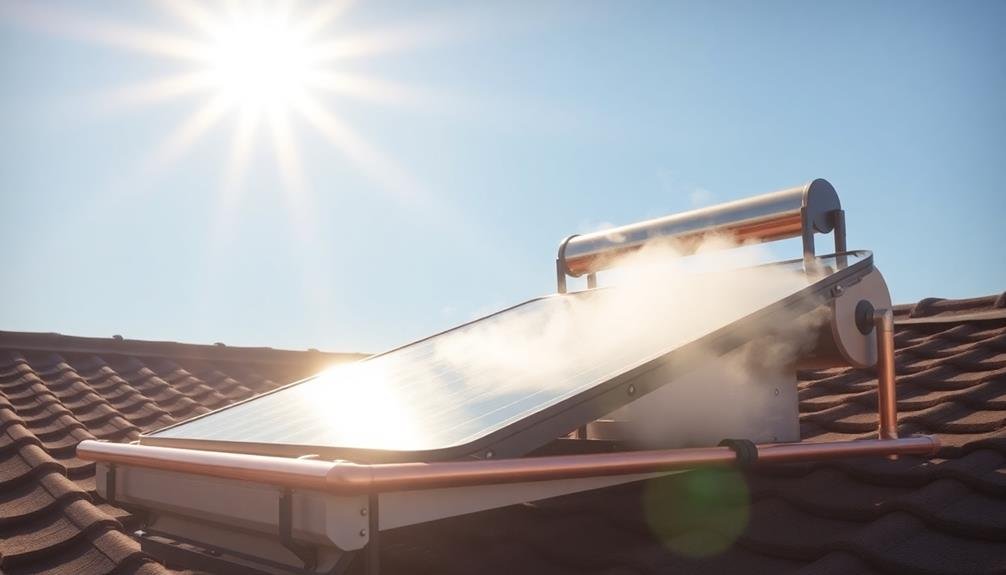
Enthusiasm for eco-friendly solutions has sparked interest in DIY solar water heater projects. You can build your own solar water heater with readily available materials and basic plumbing skills. These systems typically consist of a collector, storage tank, and circulation system.
Before starting your project, consider your climate, available space, and local regulations. Choose between two main types: batch collectors, which are simpler but less efficient, or flat-plate collectors, which offer better performance but require more complex installation.
To create a vivid picture of the DIY process, imagine:
- Mounting a large, black-painted tank on your roof to absorb sunlight
- Connecting copper pipes in a serpentine pattern across a reflective panel
- Insulating the entire system with foam boards to retain heat
Remember to factor in safety considerations, such as proper roof support and freeze protection in colder climates.
While DIY projects can be cost-effective, they may not qualify for the same incentives as professionally installed systems. Weigh the pros and cons carefully before commencing your solar water heater adventure.
Frequently Asked Questions
Can Solar Water Heaters Work During Power Outages?
Yes, many solar water heaters can work during power outages. You'll still have hot water if you've got a passive system or one with a battery backup. However, active systems without backup power may not function properly.
How Do Solar Water Heaters Affect Home Insurance Premiums?
Solar water heaters can impact your home insurance premiums. You'll likely see a decrease due to their safety features and energy efficiency. However, you should inform your insurer about the installation to guarantee proper coverage.
Are There Any Health Risks Associated With Solar Heated Water?
You'll be pleased to know that solar-heated water poses no unique health risks. It's as safe as conventionally heated water. You don't need to worry about any adverse effects from using solar-heated water in your home.
Can Solar Water Heaters Be Used for Radiant Floor Heating Systems?
Yes, you can use solar water heaters for radiant floor heating systems. They'll warm your floors effectively, especially in milder climates. You'll need to guarantee proper sizing and integration with your existing heating system for peak performance.
What Happens to Excess Hot Water Produced by Solar Water Heaters?
You'll find excess hot water from solar heaters isn't wasted. It's typically stored in insulated tanks for later use. You can also use it for other household needs or redirect it to heat pools or spas.
In Summary
You've now explored the world of solar water heating, from collector types to storage options. You're equipped to choose between passive and active systems, understand heat transfer fluids, and integrate solar with existing setups. Don't forget to reflect on your climate and available incentives. Whether you're installing a professional system or tackling a DIY project, you're ready to harness the sun's power for eco-friendly, cost-effective water heating. Embrace this sustainable technology and enjoy the benefits.

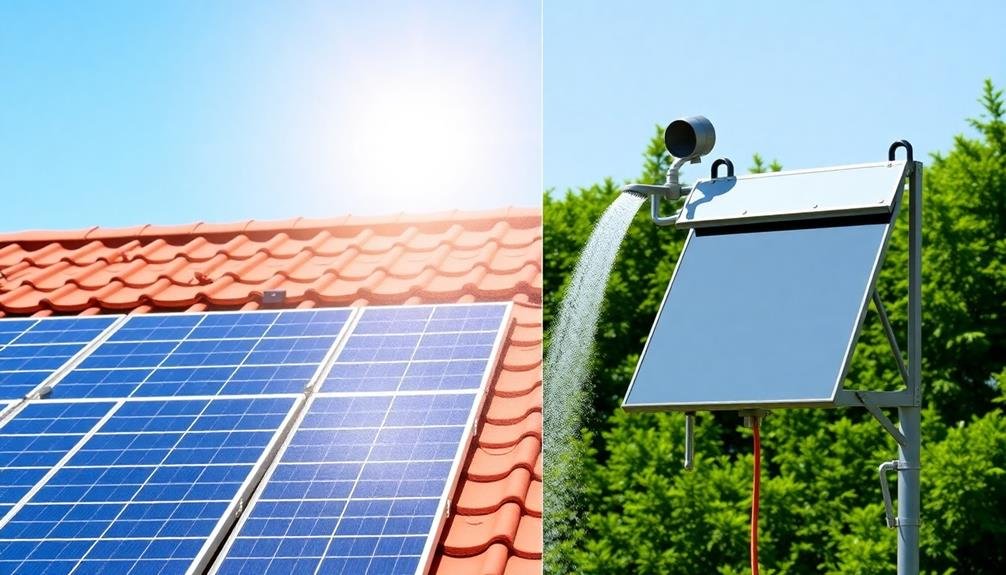
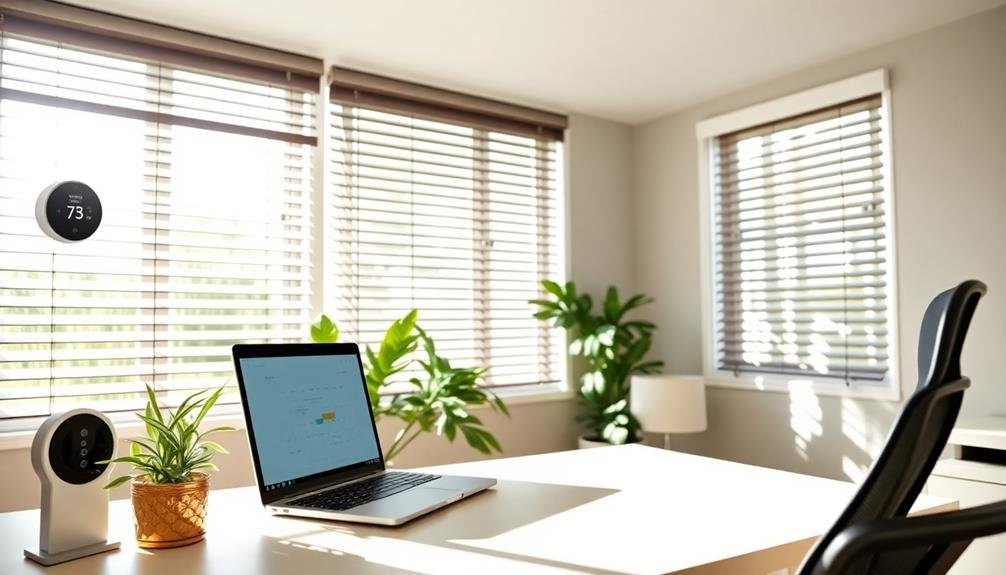
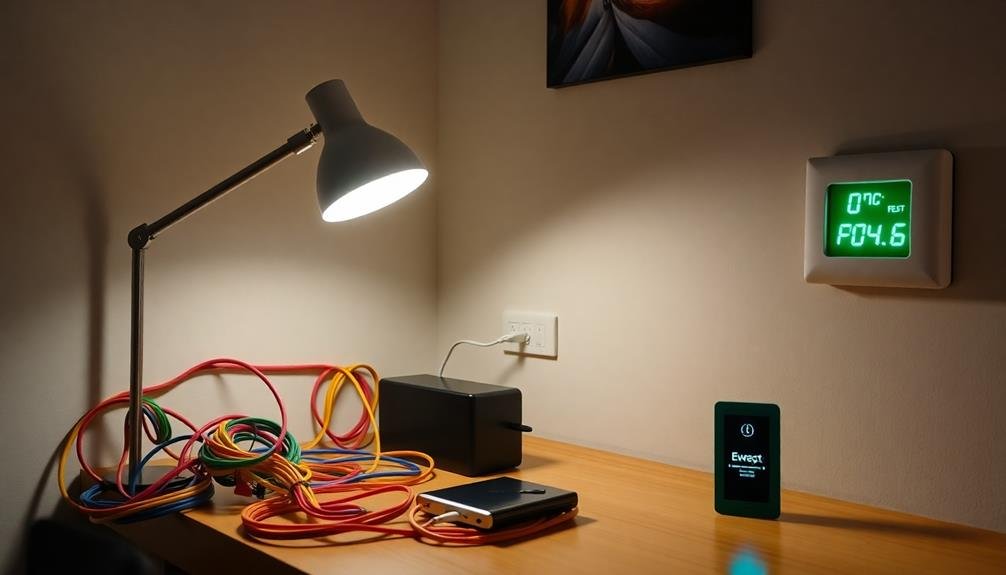
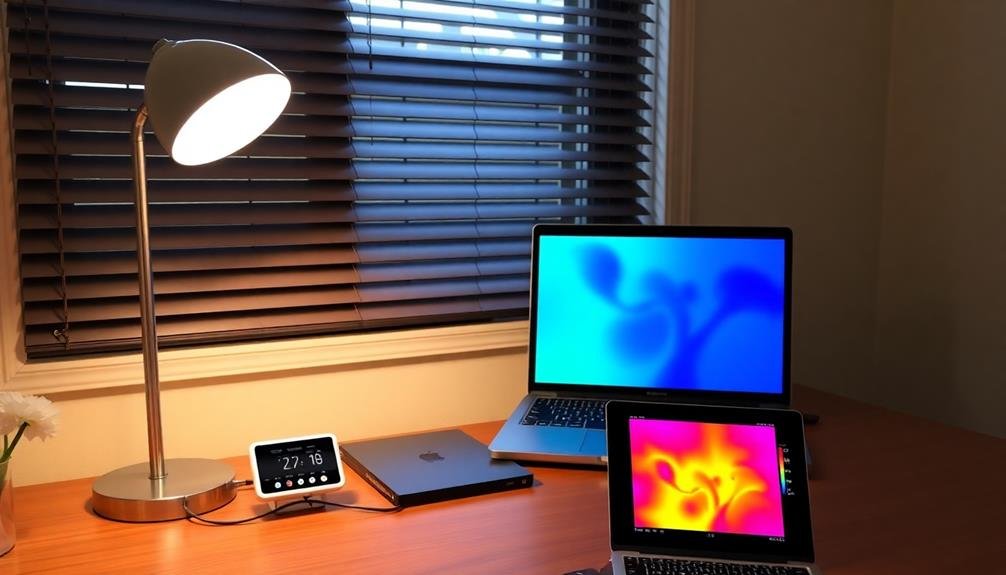
Leave a Reply